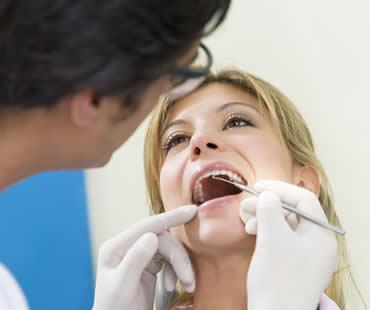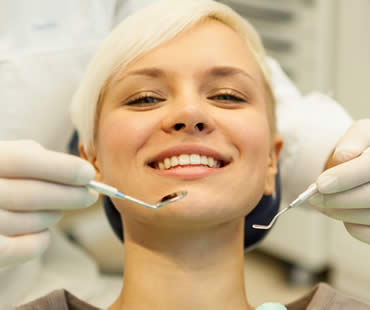
by Dr. Adkins | Mar 8, 2019 | Blog, Dental Topics 1, General Dentistry
Brush and brush and brush, but you probably will not be able to get rid of all the plaque on your teeth. Even with regular brushing, some amount of plaque will build up on your teeth and turn into a hard substance called tartar. It simply can’t be removed without professional help.
What is tartar?
Tartar is a hard, yellow or brown deposit that forms on your teeth both above and below your gum line. Any food particles remaining in your mouth after eating will breed bacteria, which creates a thin film on your teeth called plaque. Any plaque that isn’t removed with brushing and flossing will harden to create tartar.
Is it harmful?
Tartar makes the surface of your teeth rough, which attracts food particles and therefore accelerates tartar formation. If you allow tartar to continue building up, your teeth will become discolored and your gums will be at risk. You will likely develop gingivitis, in which your gums become swollen and red. They will bleed easily and become painful, and eventually can lead to tooth loss. Advanced gum disease is even linked to higher risks of stroke, heart attack, and lung disease.
How is it removed?
Tartar is too hard and stubborn to be removed with regular brushing. The only effective way to eliminate tartar is by visiting your dentist and having it removed using professional equipment. This procedure is commonly called scaling.
Can I prevent tartar buildup?
Regular brushing at least twice daily with a fluoride toothpaste can help reduce tartar formation. Unfortunately, even with proper dental hygiene, plaque buildup is inevitable over time and will become tartar. Schedule regular checkups with your dentist to have professional cleanings performed.
If you need a dentist in McDonough contact us today

by Dr. Adkins | Jan 18, 2019 | Blog, Dental Topics 1, General Dentistry
A number of serious health problems like cancer are linked to smoking, but your oral health is also at risk from using tobacco. Your teeth can be severely stained, turning them yellow or brown, and your lips can become darker too. Smokers have a higher risk of tooth decay, and bad breath is nearly inevitable. The negative outcomes of smoking continue to worsen the longer you keep doing it, so it’s highly advisable to kick the habit. However, as most smokers can attest, giving it up is not easy. Here are some tips that may help you quit smoking.
Make a list
Create a list of the reasons you’d like to quit smoking, and look at it often to remind you of your goals and the benefits you’ll achieve. These may include things like improving your overall health, restoring your smile, making loved ones proud of you, and even saving money.
Choose a date
Select a date on the calendar to stop, and stick to it. Having a concrete target can help you focus on the challenge ahead.
Ask for help
The support and encouragement from others can be a huge part of quitting smoking. Tell your family and friends about your goal, and allow them to play a part in accomplishing it.
Occupy your mouth
Sucking on sugarless candy or mints can keep your mouth busy, so you’ll be less inclined to put a cigarette in it. Chewing sugar-free gum is another great remedy for the urge to light up.
Keep busy
Try to find things to occupy your time and mind so that you aren’t constantly thinking about smoking. Take up a new hobby that involves both your mind and your hands so that you are busy with other, more beneficial, activities than puffing on a cigarette.
We treat patients from McDonough and the surrounding area

by Dr. Adkins | Nov 16, 2018 | Blog, Dental Topics 2, General Dentistry
You might think that the point of going to your general dentist is for cleanings and maybe an occasional filling. But you are wrong if you believe that’s all your dentist can offer you! A wide variety of treatments is available at a typical general dentist’s office.
Most visits to your general dentist include an initial consultation, thorough examination, and diagnostic tests if needed like dental x-rays. You’ll have the opportunity to express any problems or concerns you have, and your dentist will identify any issues that you might not be aware you have. You can also expect a meticulous professional cleaning to eliminate tartar buildup and stains that you may not have been able to get rid of at home.
You can expect these common procedures at many general dentistry practices:
- Fillings – to repair damage caused by tooth decay, often using composite resin material to provide a strong yet cosmetically appealing solution.
- Bonding – using composite resin to repair issues like cracks, chips, gaps or stains.
- Crowns – also called caps, these restorations are fitted over damaged or broken teeth to restore tooth structure and function, and to protect them from future damage.
- Bridges – to replace missing teeth, a bridge structure anchors an artificial tooth or teeth. Crowns fit over natural teeth on both sides of a gap, in which the artificial tooth replaces a missing tooth to provide a natural appearance and functional replacement.
- Dentures – if a number of teeth are missing, dentures are removable false teeth with the goal of functioning and looking like real teeth.
- Root canal treatment – when the interior pulp of a tooth is badly damaged or infected, this procedure removes the faulty portion and completely restores the tooth to avoid tooth loss.
- Teeth whitening – when teeth have become discolored with age, tobacco use, diet, or more, it can be very difficult to restore their white shade without the aid of professional whitening. General dentists may offer at-home kits or in-office whitening treatments.
- Maxillofacial treatments – mouth, jaw, or facial procedures are sometimes offered, including options like TMJ treatment or dental implants.
If you live in the McDonough area contact us today

by Dr. Adkins | Sep 7, 2018 | Blog, Dental Topics 2, General Dentistry
Don’t put off choosing a general dentist until an emergency forces you to seek care from any dentist you can find. A better choice is to select the right dentist for you and your family who meets all your needs and to get established with regular checkups and consistent care. When searching for a general dentist, here are some guidelines to help you through the process.
Services:
Ask what procedures and treatments that the dentist offers. Make sure that the services you’re interested in are provided and that the dentist has experience in performing them. Typical services available through many general dentists include professional cleanings, X-rays, fillings, bonding, root canal treatment, teeth whitening, veneers, dental implants, and more.
Qualifications:
Check to see that the dentist has the proper education and training to be practicing, as well as a valid license. Look for a dentist who pursues continuing education in order to maintain the latest and most efficient skills.
Location:
You are more likely to keep your appointments if the dental office is located near your home or work. This makes stopping in for checkups easier with less impacts on your busy schedule.
Comfort:
Personal comfort is one of the most important aspects of your dental visits. Not only should the office environment be comfortable and appealing, your interactions with the dentist and staff should also make you feel at ease. Look for professionals who listen to what you have to say and address all of your concerns. Nerves are a common part of dental visits for many people, so find a dentist who makes you feel relaxed and more likely to return for care.
Policies:
Ask questions about various policies of the dental office such as hours, emergency care, financial responsibilities, insurance plans, and any other policies that might affect you.
Our dental office is located in McDonough

by Dr. Adkins | Jul 20, 2018 | Blog, Dental Topics 1, General Dentistry
If you have a dental emergency, for example a knocked out tooth or jaw injury, contact your dentist in McDonough right away for care. Quite often dental problems will develop out of office hours, so it’s a good idea to know how to treat them until you can visit your dentist. The following tips will help you take care of yourself or someone close:
- Bitten Cheeks, Lips or Gums. Gently rinse the affected area using cool water. Use light but firm pressure to apply a clean piece of gauze or washcloth to stop bleeding. An ice pack can help reduce swelling.
- Bleeding Gums. Bleeding gums are frequently caused by gum disease or through brushing your teeth too hard. Rinse your mouth with warm water and be sure to thoroughly brush and floss your teeth as this will help reduce infection and inflammation. Book an appointment with your family dentist in McDonough for proper diagnosis and treatment.
- Canker Sores. It can help to wash the area with warm salt water. Avoid spicy or very hot foods until the canker sore begins to heal. If it fails to heal after two weeks, contact your dentist for advice.
- Cracked or Broken Tooth. Carefully rinse your mouth with warm salt water. Book an appointment with your dentist to have the tooth mended, and bring any broken pieces of tooth with you to the dental office.
- Loose Baby Tooth. Don’t attempt to pull out the tooth yourself, but instead encourage the child to gently wiggle it from side to side until it eventually comes out on its own.
- Teething Problems. Use a chilled teething ring or a cold washcloth to help soothe your baby’s gums. Gently rubbing the gums can also relieve some of the pressure.
If you live in the McDonough area contact us today

by Dr. Adkins | Jul 13, 2018 | Blog, Dental Topics 1, General Dentistry
Most people are well aware certain foods are bad for teeth, but did you know some are very good for oral health? Listed below are just a few of the foods that could help your teeth and gums stay in tip top condition.
Salmon
Salmon is packed full of vitamin D which helps your body to absorb calcium from other foods, keeping your teeth and bones strong and healthy.
Onions
Onions might give you temporary bad breath, but they also contain sulfur that lowers the amount of decay causing bacteria in your mouth.
Strawberries
Strawberries are high in fiber and vitamins C, ensuring your gums are able to repair themselves and fight infection.
Pineapple
Pineapple is also high in vitamins C as well as an enzyme called Bromelain which helps promote healing. In addition pineapple increases saliva production, helping to wash away excess bacteria and sugars that could cause disease.
Quinoa
This fashionable grain is full of minerals including magnesium, manganese, phosphorus and calcium, all of which help strengthen your teeth.
Sesame Seeds
Sesame seeds contain plenty of calcium, helping to strengthen your teeth.
Shiitake Mushrooms
Shiitake mushrooms not only taste delicious, but also contain something called Lentinan which helps prevent the growth of bacteria in your mouth.
Wasabi
Wasabi is a type of Japanese horseradish that contains particular compounds that inhibit the growth of bacteria in your mouth.
Sea Salt
Sea salt contains numerous different minerals that help strengthen teeth.
Xylitol
Your dentist in Reno may recommend chewing xylitol gum after every meal as this ingredient helps inhibit bacterial growth, reducing the risk of gum disease and cavities.
Stevia
Ordinary sugar promotes bacterial growth, increasing acidity in the mouth. Stevia is a natural sweetener that doesn’t have this effect.
Of course a great diet is only half the story, and needs to be backed up with professional dental care from your dentist in Reno, and great daily dental care at home.
Visit our McDonough dental office for a dental cleaning.








 (470) 665-5292
(470) 665-5292  E-Mail Us
E-Mail Us 
